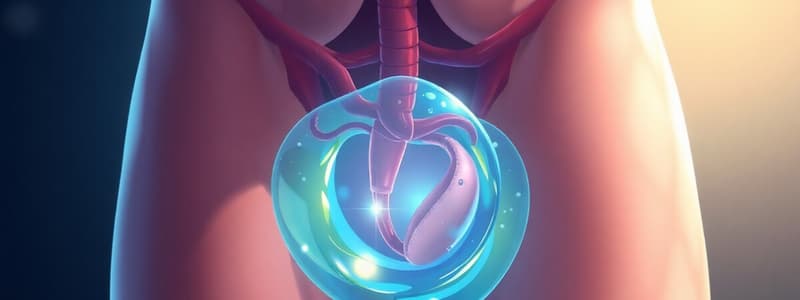Podcast
Questions and Answers
Which of the following best describes the pathophysiology of a hydrocele?
Which of the following best describes the pathophysiology of a hydrocele?
- Benign cystic dilation of the epididymal ducts.
- Fluid accumulation within the tunica vaginalis. (correct)
- Twisting of the spermatic cord.
- Dilation of the pampiniform venous plexus.
What diagnostic finding is most indicative of a hydrocele during a physical examination?
What diagnostic finding is most indicative of a hydrocele during a physical examination?
- Scrotal mass that feels like a 'bag of worms'.
- Non-palpable testis in the scrotum.
- Positive transillumination. (correct)
- Absent cremasteric reflex.
A varicocele is most commonly found on which side?
A varicocele is most commonly found on which side?
- Both sides equally.
- Right side.
- Alternating sides.
- Left side. (correct)
Which of the following is a potential long-term consequence of a varicocele if left untreated?
Which of the following is a potential long-term consequence of a varicocele if left untreated?
What is the underlying pathophysiology of a spermatocele?
What is the underlying pathophysiology of a spermatocele?
A 30-year-old male presents with a painless, movable cystic mass superior to the testicle. Which condition is most likely?
A 30-year-old male presents with a painless, movable cystic mass superior to the testicle. Which condition is most likely?
Which of the following conditions necessitates emergency surgical intervention to prevent necrosis?
Which of the following conditions necessitates emergency surgical intervention to prevent necrosis?
What physical exam finding is most indicative of testicular torsion?
What physical exam finding is most indicative of testicular torsion?
What is the primary underlying issue in cryptorchidism?
What is the primary underlying issue in cryptorchidism?
Cryptorchidism increases the risk of which complication if not corrected?
Cryptorchidism increases the risk of which complication if not corrected?
A newborn is examined and one testis is not palpable in the scrotum. Where might the missing testis most likely be located?
A newborn is examined and one testis is not palpable in the scrotum. Where might the missing testis most likely be located?
Which condition presents with sudden, severe unilateral scrotal pain?
Which condition presents with sudden, severe unilateral scrotal pain?
Which of the following conditions is LEAST likely to affect fertility?
Which of the following conditions is LEAST likely to affect fertility?
Which condition is characterized by dilation of the pampiniform venous plexus?
Which condition is characterized by dilation of the pampiniform venous plexus?
A patient is diagnosed with a varicocele. Which of the following signs or symptoms would be MOST expected during physical examination?
A patient is diagnosed with a varicocele. Which of the following signs or symptoms would be MOST expected during physical examination?
Which condition is most commonly seen in adolescents?
Which condition is most commonly seen in adolescents?
Which condition almost always transilluminates?
Which condition almost always transilluminates?
Which condition, if untreated, can lead to infarction?
Which condition, if untreated, can lead to infarction?
A patient presents with a mass separated and superior to the testicle. Which of the following is the most likely diagnosis?
A patient presents with a mass separated and superior to the testicle. Which of the following is the most likely diagnosis?
While transillumination is an important test, in which condition is it MOST useful?
While transillumination is an important test, in which condition is it MOST useful?
Flashcards
Hydrocele
Hydrocele
Fluid accumulation within the tunica vaginalis, the sac surrounding the testicle.
Varicocele
Varicocele
Dilation of the pampiniform venous plexus in the spermatic cord, most common on the left side.
Spermatocele
Spermatocele
Benign cystic dilation of the epididymal ducts, containing sperm and fluid.
Testicular Torsion
Testicular Torsion
Signup and view all the flashcards
Cryptorchidism
Cryptorchidism
Signup and view all the flashcards
Tunica Vaginalis
Tunica Vaginalis
Signup and view all the flashcards
Pampiniform Venous Plexus
Pampiniform Venous Plexus
Signup and view all the flashcards
Epididymal Ducts
Epididymal Ducts
Signup and view all the flashcards
Spermatic Cord
Spermatic Cord
Signup and view all the flashcards
Testes Descend
Testes Descend
Signup and view all the flashcards
Transillumination test
Transillumination test
Signup and view all the flashcards
Adolescents
Adolescents
Signup and view all the flashcards
Surgical Emergency
Surgical Emergency
Signup and view all the flashcards
Unilateral scrotal pain
Unilateral scrotal pain
Signup and view all the flashcards
Testicular Cancer
Testicular Cancer
Signup and view all the flashcards
Study Notes
Hydrocele
- Fluid accumulates within the tunica vaginalis
- The tunica vaginalis is the sac surrounding the testicle
- Can result from a congenital defect, injury/infection such as epididymitis, or an imbalance between secretion and reabsorption of fluid
- Clinical manifestations include soft, painless scrotal swelling
- A positive transillumination test occurs because light passes through the fluid
- Size may fluctuate throughout the day
Varicocele
- Dilation of the pampiniform venous plexus occurs in the spermatic cord
- More common on the left side because of drainage into the left renal vein
- Associated with impaired venous drainage, possibly from valve failure or compression of the renal vein
- Can impair testicular function by increasing scrotal temperature
- Clinical manifestations include being asymptomatic, or feeling like a "bag of worms"
- Scrotal aching or heaviness can occur, especially after standing or physical activity
- Can lead to infertility
Spermatocele
- Benign cystic dilation of the epididymal ducts occurs
- Contains sperm and fluid
- Clinical manifestations include a painless, movable cystic mass superior to and separate from the testicle
- Transilluminates, and typically does not affect fertility
Testicular Torsion
- Twisting of the spermatic cord obstructs venous drainage, leading to arterial ischemia
- Can result in testicular infarction if not promptly treated
- Most common in adolescents
- Clinical manifestations include sudden, severe unilateral scrotal pain as well as swelling, nausea, and vomiting
- An absent cremasteric reflex, a high-riding testicle, or horizontal lie should also be noted
- Considered a surgical emergency and requires intervention within 6 hours to prevent necrosis
Cryptorchidism
- One or both testes fail to descend into the scrotum
- Can occur due to hormonal abnormalities, mechanical obstruction, or prematurity
- Prematurity is when the testes descend late in gestation
- If not corrected, the risk of testicular cancer and infertility increases
- Clinical manifestations include a non-palpable testis in the scrotum
- May be located in the inguinal canal or abdomen
- Often discovered in infancy or early childhood
Studying That Suits You
Use AI to generate personalized quizzes and flashcards to suit your learning preferences.




